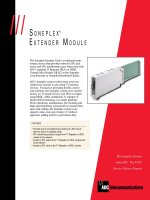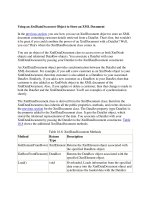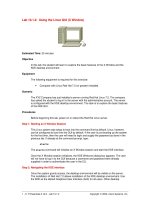Tài liệu Using Manual Transactions pdf
Bạn đang xem bản rút gọn của tài liệu. Xem và tải ngay bản đầy đủ của tài liệu tại đây (16.34 KB, 4 trang )
[ Team LiB ]
Recipe 6.2 Using Manual Transactions
Problem
You need to explicitly begin, control, and end a transaction within a .NET application.
Solution
Use the Connection object with structured exceptions (try . . . catch . . . finally).
The sample code contains two event handlers:
Form.Load
Sets up the sample by filling a DataTable with the Categories table from the
Northwind sample database. The default view of the table is bound to a data grid
on the form.
Insert Button.Click
Inserts user-entered data for two Categories records into the Northwind database
within a manual transaction. If either record insert fails, both inserts are rolled
back; otherwise, both record inserts are committed.
The C# code is shown in Example 6-3
.
Example 6-3. File: ManualTransactionForm.cs
// Namespaces, variables, and constants
using System;
using System.Configuration;
using System.Windows.Forms;
using System.Data;
using System.Data.SqlClient;
private const String CATEGORIES_TABLE = "Categories";
private DataTable dt;
private SqlDataAdapter da;
// . . .
private void ManualTransactionForm_Load(object sender, System.EventArgs e)
{
// Fill the categories table.
String sqlText = "SELECT CategoryID, CategoryName, " +
"Description FROM Categories";
da = new SqlDataAdapter(sqlText,
ConfigurationSettings.AppSettings["Sql_ConnectString"]);
dt = new DataTable(CATEGORIES_TABLE);
da.FillSchema(dt, SchemaType.Source);
da.Fill(dt);
// Bind the default view of the table to the grid.
dataGrid.DataSource = dt.DefaultView;
}
private void insertButton_Click(object sender, System.EventArgs e)
{
String sqlText = "INSERT " + CATEGORIES_TABLE + " "+
"(CategoryName, Description) VALUES " +
"(@CategoryName, @Description)";
// Create the connection.
SqlConnection conn = new SqlConnection(
ConfigurationSettings.AppSettings["Sql_ConnectString"]);
// Create the transaction.
conn.Open( );
SqlTransaction tran = conn.BeginTransaction( );
// Create command in the transaction with parameters.
SqlCommand cmd = new SqlCommand(sqlText, conn, tran);
cmd.Parameters.Add(new SqlParameter("@CategoryName",
SqlDbType.NVarChar, 15));
cmd.Parameters.Add(new SqlParameter("@Description",
SqlDbType.NVarChar, 100));
try
{
// Insert the records into the table.
if (categoryName1TextBox.Text.Trim( ).Length == 0)
// If CategoryName is empty, make it null (invalid).
cmd.Parameters["@CategoryName"].Value = DBNull.Value;
else
cmd.Parameters["@CategoryName"].Value =
categoryName1TextBox.Text;
cmd.Parameters["@Description"].Value =
description1TextBox.Text;
cmd.ExecuteNonQuery( );
if (categoryName2TextBox.Text.Trim( ).Length == 0)
cmd.Parameters["@CategoryName"].Value = DBNull.Value;
else
cmd.Parameters["@CategoryName"].Value =
categoryName2TextBox.Text;
cmd.Parameters["@Description"].Value =
description2TextBox.Text;
cmd.ExecuteNonQuery( );
// If okay to here, commit the transaction.
tran.Commit( );
MessageBox.Show("Transaction committed.");
}
catch (Exception ex)
{
// Exception occurred. Roll back the transaction.
tran.Rollback( );
MessageBox.Show(ex.Message + Environment.NewLine +
"Transaction rollback.");
}
finally
{
conn.Close( );
}
// Refresh the data.
da.Fill(dt);
}
Discussion
Manual transactions allow control over the transaction boundary through explicit
commands to start and end the transaction. There is no built-in support for distributed
transactions spanning multiple resources with manual transactions.
.NET data providers make available objects to enable manual transactions. The
Connection object has a BeginTransaction( ) method that is used to start a transaction. If
successful, the method returns a Transaction object that is used to perform all subsequent
actions associated with the transaction, such as committing or aborting. Calling the
BeginTransaction( ) method does not implicitly cause all subsequent commands to
execute within the transaction. The Transaction property of the Command object must be
set to a transaction that has already been started for the command to execute within the
transaction.
Once started, the transaction remains in a pending state until it is explicitly committed or
rolled back using the Commit( ) or Rollback( ) methods of the Transaction object. The
Commit( ) method of the Transaction is used to commit the database transaction. The
Rollback( ) method of the Transaction is used to roll back a database transaction from a
pending state. An InvalidOperationException will be raised if Rollback( ) is called after
Commit( ) has been called.
The isolation level of the transaction can be specified through an overload of the
BeginTransaction( ) method and if it is not specified, the default isolation level
ReadCommitted is used.
Unlike automatic transactions, manual transactions must be explicitly committed or
rolled back using the Commit( ) or Rollback( ) method. If possible, use the .NET data
provider transaction management exclusively; avoid using other transaction models, such
as the one provided by SQL Server. If this is necessary for any reason, Recipe 6.3
discusses using the SQL Server transaction model together with the .NET SQL Server
data provider transaction management.
The IDbTransaction interface is implemented by .NET data providers that access
relational databases. Applications create an instance of the class implementing the
IDbTransaction interface rather than creating an instance of the interface directly. Classes
that inherit IDbTransaction must implement the inherited members and typically define
provider-specific functionality by adding additional members.
The SQL .NET data provider allows savepoints to be defined allowing a transaction to be
partially rolled back to a point in the transaction other than its beginning. The OLE DB
.NET data provider allows nested transactions to be started within the parent transaction;
the parent transaction cannot commit until all its nested transactions have committed.
[ Team LiB ]









